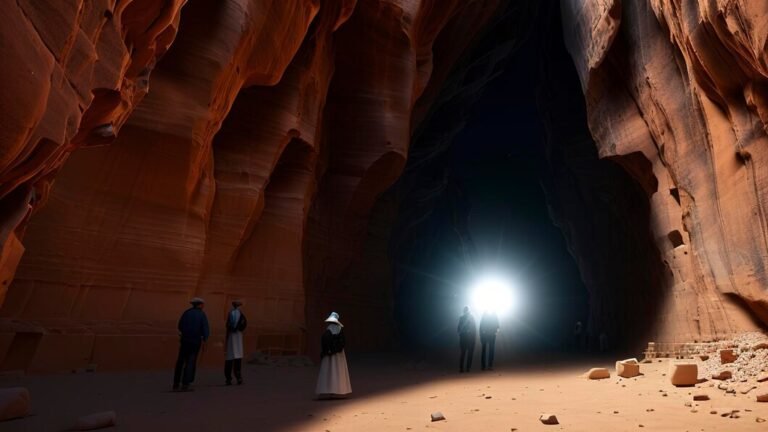The “Canyon of the Crescent Moon” is a stunning landmark, famously depicted in Indiana Jones and the Last Crusade. The location, although fictionalized in the movie, draws inspiration from the real-world marvel of Petra, an ancient city carved into the rose-red cliffs of southern Jordan. This awe-inspiring site has captivated explorers and adventurers for centuries. In this article, we’ll dive into the fascinating history, geography, and cultural significance of Petra, the true setting of the iconic Canyon of the Crescent Moon, while also exploring how this magical place was brought to life on screen.
Petra: The Heart of the Canyon of the Crescent Moon
Petra, the ancient capital of the Nabatean Kingdom, is one of the world’s most significant archaeological sites and a UNESCO World Heritage site. The narrow gorge called the Siq leads visitors through dramatic rock formations to the first view of Al Khazneh, or The Treasury, which was immortalized in the Indiana Jones movie. This extraordinary facade, hewn from the sandstone rock, is the most famous of Petra’s many tombs and temples, and it is featured as the “Canyon of the Crescent Moon” in the film.
The Role of Petra in Indiana Jones
In Indiana Jones and the Last Crusade, the Canyon of the Crescent Moon serves as the gateway to the legendary Holy Grail, hidden deep within the heart of Petra. This dramatic location is where Indy and his father, played by Sean Connery, face off with the Nazis in a race to discover the Grail. The movie’s portrayal of Petra as a mystical, treasure-laden locale has further cemented the city’s place in popular culture.
Though the “Canyon of the Crescent Moon” itself is fictional, the stunning landscapes and monuments featured in the movie are very much real. Al Khazneh, the Treasury, is believed to have been a royal tomb, with its intricate carvings and towering columns reflecting the advanced engineering skills of the Nabateans. Petra, with its rugged beauty and historical significance, has become a symbol of ancient mystery and adventure, making it a must-see for anyone interested in history, archaeology, and cinematic history.
Visiting Petra: A Journey Through Time
Petra’s allure lies not only in its cinematic fame but also in its rich history. The city was once a thriving trade hub, strategically located along ancient caravan routes connecting the Arabian Peninsula with the Mediterranean world. The Nabateans, known for their expertise in water management, carved elaborate structures into the sandstone cliffs, including temples, tombs, and a complex system of channels that brought water to the city.
Today, Petra continues to be a popular tourist destination, drawing visitors from all over the globe. The journey to the Treasury is a highlight for most, with visitors walking through the Siq, a narrow, winding gorge flanked by towering rock faces. The view that awaits at the end of the Siq—The Treasury bathed in the golden light of the setting sun—is nothing short of breathtaking.
Beyond the Canyon: Other Notable Sites in Petra
While the Treasury is undoubtedly the most famous structure in Petra, the city is home to a wealth of other remarkable monuments. These include the Monastery (Al-Deir), which sits high on a hill and requires a steep climb to reach, as well as the Royal Tombs, which showcase the Nabateans’ expertise in architecture and artistry.
The entire Petra archaeological park spans over 100 square kilometers, offering endless opportunities for exploration. Whether hiking through the rugged desert landscape or exploring the ancient ruins, Petra remains a place of wonder and discovery.
The Legacy of the Canyon of the Crescent Moon
Petra’s role as the Canyon of the Crescent Moon in Indiana Jones and the Last Crusade has only heightened its mystique. The film’s global success brought the site’s grandeur to a wider audience, sparking a renewed interest in the history of the Nabatean civilization and the cultural significance of the region. Today, Petra is not just a historical treasure but a symbol of adventure, mystery, and timeless beauty.
Comparison Chart: Petra vs. Canyon of the Crescent Moon
| Feature | Petra (Real-life) | Canyon of the Crescent Moon (Film) |
|---|---|---|
| Location | Jordan, Middle East | Fictional location based on Petra |
| Significance | Ancient Nabatean city, UNESCO site | Fictional setting for the Holy Grail quest |
| Main Attraction | Al Khazneh (The Treasury) | The Treasury, as the gateway to the Grail |
| History | Founded in the 4th century BC, abandoned in the 7th century AD | Part of the film’s dramatic finale |
| Visitor Experience | Walk through the Siq, explore tombs, climb to the Monastery | Adventure-filled chase and exploration |
Final Thoughts
The “Canyon of the Crescent Moon” may be a cinematic creation, but it is rooted in the rich history and breathtaking landscapes of Petra. Whether you’re a fan of adventure films or a lover of ancient history, this extraordinary place offers something for everyone. As you explore its winding paths and towering facades, you’ll find that Petra, like the iconic Canyon of the Crescent Moon, holds timeless secrets waiting to be discovered.

